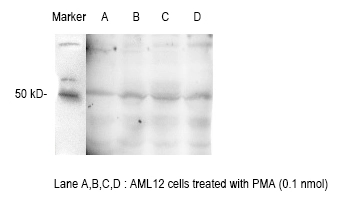E2F1 antibody [18E10]
GTX70165
ApplicationsImmunoFluorescence, ImmunoPrecipitation, Western Blot, ImmunoCytoChemistry, ImmunoHistoChemistry, ImmunoHistoChemistry Paraffin
Product group Antibodies
TargetE2F1
Overview
- SupplierGeneTex
- Product NameE2F1 antibody [18E10]
- Delivery Days Customer9
- ApplicationsImmunoFluorescence, ImmunoPrecipitation, Western Blot, ImmunoCytoChemistry, ImmunoHistoChemistry, ImmunoHistoChemistry Paraffin
- CertificationResearch Use Only
- ClonalityMonoclonal
- Concentration1 mg/ml
- ConjugateUnconjugated
- Gene ID1869
- Target nameE2F1
- Target descriptionE2F transcription factor 1
- Target synonymsE2F-1; PBR3; PRB-binding protein E2F-1; RBAP1; RBAP-1; RBBP3; RBBP-3; RBP3; retinoblastoma-associated protein 1; retinoblastoma-binding protein 3; transcription factor E2F1
- HostMouse
- IsotypeIgG1
- Protein IDQ01094
- Protein NameTranscription factor E2F1
- Scientific DescriptionThe protein encoded by this gene is a member of the E2F family of transcription factors. The E2F family plays a crucial role in the control of cell cycle and action of tumor suppressor proteins and is also a target of the transforming proteins of small DNA tumor viruses. The E2F proteins contain several evolutionally conserved domains found in most members of the family. These domains include a DNA binding domain, a dimerization domain which determines interaction with the differentiation regulated transcription factor proteins (DP), a transactivation domain enriched in acidic amino acids, and a tumor suppressor protein association domain which is embedded within the transactivation domain. This protein and another 2 members, E2F2 and E2F3, have an additional cyclin binding domain. This protein binds preferentially to retinoblastoma protein pRB in a cell-cycle dependent manner. It can mediate both cell proliferation and p53-dependent/independent apoptosis. [provided by RefSeq, Jul 2008]
- Storage Instruction-20°C or -80°C,2°C to 8°C
- UNSPSC12352203
References
- A tri-marker proliferation index predicts biochemical recurrence after surgery for prostate cancer. Malhotra S et al., 2011, PLoS OneRead more
- Structure of the human Papillomavirus E7 oncoprotein and its mechanism for inactivation of the retinoblastoma tumor suppressor. Liu X et al., 2006 Jan 6, J Biol ChemRead more

![IHC-P analysis of human breast carcinoma tissue using GTX24070 E2F1 antibody [KH95].](https://www.genetex.com/upload/website/prouct_img/normal/GTX24070/GTX24070_20191203_IHC-P_112_w_23060722_159.webp)

![ICC/IF analysis of 4% PFA-fixed HeLa cells using GTX66839 E2F1 antibody [4G8]. Blue : DAPI Dilution : 1:100](https://www.genetex.com/upload/website/prouct_img/normal/GTX66839/GTX66839_20190305_ICCIF_w_23061221_558.webp)

